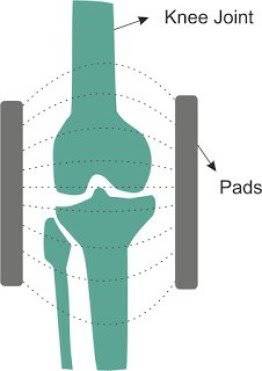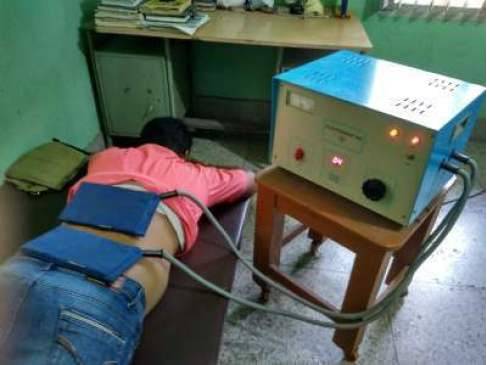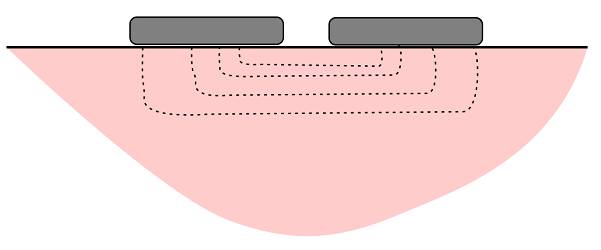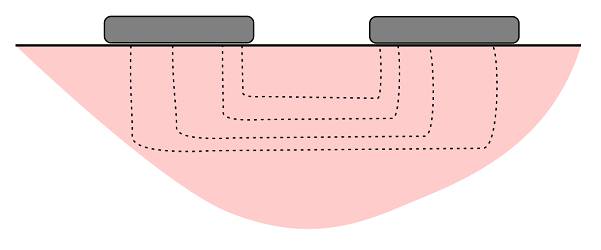-

opening hours
mon-sat 09:00-22:00 -

call us
+91-7428590021
opening hours
mon-sat 09:00-22:00
call us
+91-7428590021

The short form of short wave diathermy is SWD, which is the term we commonly use in our clinical practice.
The term diathermy in “short wave diathermy” means heating through, it could be any object through which the wave passes through to produces heat inside the object. Since our body is made up of tissues, the SWD machine produces heat in the tissue.
A typical SWD machine has a unit with all the components and controls. It has a power on and off switch, timer, knob to control the intensity and tuner for tuning two electrodes.
This unit has two output which is connected to pads or disc with a thick wire. The pads/ disc is placed over the patient’s body part for treatment purpose.
Depending upon the convenience one may use either disc or pads.
The working principle of SWD What makes short wave diathermy different from other heating agents? How it produces heating in deeper tissues? One of the most important differences is its ability to heat deeper tissues of our body.
The other source of the heat like hot towels, infrared lamps and electric heating pads produce heating first at skin level and it does not penetrate to a deeper level. This causes discomfort and burning sensation over the skin long before the adequate heat has penetrated to the deeper tissues.
Another advantage of diathermy is that we can have precise control over the amount of heat delivered for the treatment. Careful placement of the electrodes permits localization of the heat to the treatment region.
Short wave diathermy frequency
The heating of the tissues is the result of high-frequency alternating current which generally have a frequency 27.12 MHz and a wavelength of 11 meters. Currents of such high frequencies do not stimulate motor or sensory nerves nor do they produce any muscle contraction.

Frequency = 27.12MHz (number of wave per second)
Short wave diathermy machine
Short wave diathermy is divided into two types; namely,
When the electromagnetic field is utilized, the current is conducted to the patient by means of a heavy, very flexible, insulated cable which is used as the electrode, and is coiled about or around the part to be treated.
The electric field is applied by means of condenser pad electrodes or cuff electrodes which encircle the part to be treated, and the so-called air space electrodes made of metal contained in glass, bakelite, or rubber.
The condenser pad electrode consists of a flexible metal plate between two layers of flexible rubber which prevent the current from arcing from the metal to the patient’s skin. Various machines have different sized electrodes. The cuff electrodes are similar to the condenser pad electrodes except for their size, which ranges from three to nine inches in width and from two to forty-eight inches in length.
The usual and accepted length of time for a treatment with short wave diathermy is from twenty to forty minutes. In short wave diathermy the dose or intensity of current is determined mainly by the patient’s tolerance.
SWD electrode placement
The two output of SWD machine is connected to the metal electrode via a thick cable. These metal electrode is covered by rubber padding and is used to directly position on the body over the treating region. These electrodes are called PADS.
The electrodes/pads are never kept directly in contact with the skin. Usually, we insert a layer of the towel between the pad and surface of the body or simply maintain 1 to 2 inches of distance from the skin
When applied to the body, they are placed so that they entirely encircle the part to be treated. The air space electrode is made of a circular disk which is adjusted within a special glass container or encased within hard or soft rubber. They are made so that the electrodes can be placed within any desired distance of the skin.
Metal pads act as two plates and the body tissues between the pads as the dielectric of the capacitor. When a radiofrequency output is applied to the pads, the dielectric losses manifest themselves as heat in the intervention tissue.
There are two methods of application of pads:

Contraplanar: In this type of , the two electrodes are placed in two different planes, this is why it is called as . The placement is such that the two pads sandwich the treating body part between them.
Let us take knee joint as an example, the two pads are placed on the two sides of the knee as shown in the figure below.
Coplanar (SWD for back pain):
As the name suggests the pads are placed on the same plane. Contrary to the arrangement, here the pads are placed side by side on the same plane. We this arrangement to treat large body such as low back or upper back.
A person receiving SWD treatment on lower back

In coplanar electrode placement avoid placing electrodes too close as the wave path does not go deeper (see figure). An optimum distance of electrode is recommended for best result.

Avoid closer placement of electrodes

Optimum distance ensures deeper penetration of waves for better effect
Short wave diathermy Contraindications.
Short wave diathermy uses electromagnetic waves for its effect. There are certain conditions where shortwave diathermy is strictly contraindicated, below are the list of them.
Indication of SWD
SWD is very effective in relieving pain, helps in the reduction of inflammation